Parks Canada public service renewal results, 2018
Table of contents
The past year has been one of the most innovative at Parks Canada. With the Canada 150 celebrations behind us, our teams looked at various opportunities for improvement within the Agency. We mobilized talent, removed some barriers to productivity, solicited internal and external advice and feedback, gathered various perspectives, and then experimented with new ways of working.
These projects not only allow us to raise awareness of our places and our cultural heritage, but also help to mobilize our members and ensure their active participation in innovative projects.
We recognize that innovation clearly involves learning, but it also requires communication among our members, and the sharing of knowledge and skills by everyone.
As skilled storytellers, we are proud to present stories that demonstrate our commitment to public service renewal and Parks Canada's commitment to better serve Canadians.
Agile Groups
Promoting Science and Conservation: #ParksInsider Videos and the Story Map
An important goal of Public Service Renewal is to build agility by empowering employees to try new approaches to their work. Two initiatives of the Brand Experience Branch—the story map and the Parks Insider videos—did exactly that.
In exploring new ways to build public interest and enthusiasm for the Agency’s science and conservation work, Brand Experience came up with the “Parks Insider” promotional campaign. This campaign has taken Canadians deep into the heart of Parks Canada’s conservation landscape by showcasing both our people and their stories.
As part of the campaign, the New Media team produced a number of short, vivid Parks Insider videos. The subjects ranged from “How a canoe trip changed my life” (interview with Parks Canada’s Climate Change Advisor Elizabeth Nelson) to “Canada’s national parks hold a dark secret” (Dark-Sky Preserves). These videos, tailored specifically for Facebook, marked a novel direction for the New Media Team. The early ones in the series combined animation with live footage, and the latter ones used snippets of on-screen text in place of narration. The videos proved unusually successful, garnering over 300,000 views on Facebook and YouTube.
Several of the Parks Insider videos, along with new web stories on science and conservation, were brought together in Parks Canada’s first-ever story map. This interactive online map combined images, text and video to take users on a virtual trip across Canada, with stops at sixteen different story locales. By venturing onto this new platform, the web team was able to gain new skills and knowledge for their story-telling toolkit.
The Parks Insider videos and the science and conservation story map are continuing to give Canadians the big picture on our conservation successes.
Birch Bark Canoe Building
Parks Canada’s Birch Bark Canoe Building exhibit at Kejimkujik National Park is a great example of how Parks Canada finds opportunities to work with communities in transparent and meaningful ways while expanding its offer of public services and increasing the capacity and skills of our employees and Indigenous communities.
The Birch Bark Canoe Building program saw Parks Canada work with members of two Nova Scotia Mi’kmaq communities to achieve a number of goals by developing programming. These goals included exploring opportunities to create sustainable tourism, creating a cultural exchange (Elder to youth within the community, and between the Mi’kmaq and the visiting public), and enhancing visitor programming to better enable visitors to experience and understand aspects of Mi’kmaq culture. A Mi’kmaw master canoe builder was brought to the site to demonstrate traditional birch bark canoe construction and hands-on programming was also established so that some visitors might develop an even greater understanding of this culturally significant work.
The Field Unit was able to maximize the impact of Indigenous Tourism funding and to work with Mi’kmaq communities to launch programs that better conveyed Mi’kmaw cultural stories to the visiting public. Agility was demonstrated through the team working to support Mi’kmaw partners by obtaining the Indigenous Tourism funding and working with the communities in an open and transparent manner. The program allowed employees to explore new skills and activities and it allowed the Park to re-purpose facilities for more current uses.
The project was inclusive in that diverse points of view were incorporated into the project development. Field Unit employees and members of local Indigenous communities with a range of different responsibilities were involved in the project. The project had employees and members of the communities play roles that developed new skills so that at the end of the project, they were better equipped to apply those skills to their ongoing activities.
Parks Canada Innovation Agents
Being decentralized with locations from coast to coast, the Agency must continually update methods to reach its members. The Innovation Lab wanted to share various information with members to discuss innovation and to share existing knowledge and skills within the Agency.
To accomplish this, we created a community of innovation agents. As representatives of our field units and Agency Directorates and being dispersed throughout the country, members of this virtual community voluntarily share information on innovation-related topics.
By becoming an innovation agent, members receive email alerts when content is shared in our GCconnex group, including articles, training and events from Parks Canada and other departments and agencies.
As VIP members, innovation agents have the opportunity to view project and product proposals from the Innovation Lab and share their comments to guide their development.
In order to spark the interest of Agency members, the Innovation Lab developed a video and posters encouraging members to become a proud Parks Canada innovation agent and act as a spokesperson in the workplace.
Parks Canada now has 35 innovation agents ready to share the Agency's innovative projects and contribute to emerging projects by expressing their views and sharing their knowledge and comments.
Innovative Solutions Marketplace
Through innovative thinking, every day we come up with incredible solutions to improve the efficiency and quality of our programs and services. How can we share these best practices?
The Innovation Lab has created the Innovation Solutions Marketplace. It is a space on our Intranet where we can share existing solutions form the Agency that my help us work better. It is also a way to submit a challenge and get tools, resources and assistance in finding a solution.
The Lab has also created a short animated video to show team members that illustrates how sharing a solution helps all Parks Canada members.
Adopting one of the solutions from the Marketplace is like taking a shortcut in solving a problem or putting in place an improvement that will have a direct impact on our work.
To this day, a total of 19 stories have been published on our Intranet page, which has received over 650 visits.
Inclusive Projects
Cross Pollination Fundy National Park
The New Brunswick South Field Unit received funding under the Species at Risk Action Plan Implementation Fund to plan and design a pollinator garden in Fundy National Park that will be suitable habitat for Yellow-banded Bumblebees and Monarch Butterflies, as well as other native pollinator species. The gardens will benefit Species at Risk pollinators and promote public engagement and awareness.
This project will not only achieve Species at Risk conservation gains but has already proven to boost cross-function morale. Resource Conservation team members have engaged the Asset Management maintenance labourers who have been tending to the long-standing exotic flower gardens in the park. Visitor Experience team members were also engaged. Together, they are developing a plan and design and acquiring materials to convert these exotic flower gardens into native pollinator gardens. The maintenance labourers’ workplace was moved to co-locate with the Resource Conservation team for this project. The energy was undeniable while the office was buzzing with sharing of ideas from different perspectives. The project will produce a positive outcome for both Species at Risk, as well as the overall team dynamic at Fundy National Park.
New Mi’kmaw Interpretive Centre – Fortress of Louisbourg National Historic Site
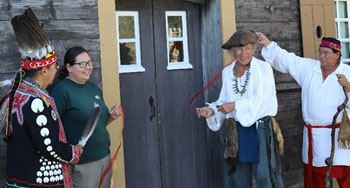
A collaboration worth sharing, the new Mi'kmaw Interpretive Centre at the Fortress of Louisbourg National Historic Site transformed an outdated exhibit area into a welcoming space where visitors and local communities enjoy a dedicated space that highlights the Indigenous story, culture, communities and historic connections on Unama’ki (Cape Breton Island). Although the space, storytelling and artifacts are all equally as impressive, the collaboration that went on behind the scenes is cause for celebration. The committee members, composed of knowledge keepers and community members from each Indigenous community in Unama’ki, came forward to provide guidance and input. Using the strengths of all committee members, the group created an exceptional product, working collaboratively to ensure the best possible results. Through this work, the centre introduces the history and culture of the Mi’kmaq, offering hands-on and engaging experiences while promoting Cape Breton Island’s Indigenous communities, as well as their community events and tourism offers.
Advertising Campaign
Parks Canada launched a bold new advertising campaign in 2018 to encourage Canadians to discover their national parks, national historic sites and national marine conservation areas, as well as to connect with nature and help in the protection of these places. This campaign, targeting families and young adults, was deployed on relevant and impactful media including television, billboards and various digital platforms.
Extensive consultations were done both internally and externally during early conceptual planning stages of the advertising campaign. Focus group testing was done with a cross-section of representative Canadians from across the country. Feedback received helped to inform and influence the campaign messaging and creative to ensure it was reflective of the values and expectations of Canadians. As well, additional cross-functional consultations were undertaken internally with Parks Canada employees and experts to ensure the campaign aligned with and contributed to Government of Canada and Agency priorities.
In order to reach Canadians in a compelling way, the campaign presented a refreshed, more energetic style using the tagline “450,000 km2 of memories”. This tagline conveys the endless memorable experiences that potential visitors to Parks Canada places can enjoy while referencing the vastness of our protected places.
One of the key creative pieces consists of the 60-second video that garnered significant attention (8.5 million views and counting!). It also features a trendy musical track composed especially for this campaign using Canadian song artists (Naya Ali in English and KNLO in French). Lyrics were not simply translated but adapted to reflect the uniqueness of each language.
The 2018 campaign generated approximately 500M media impressions, representing an estimated reach of 30M people. The campaign surpassed expectations and contributed towards strong visitation to Parks Canada locations, higher levels of awareness of Parks Canada, sustained support towards the Agency, and greater web traffic.
Stanhope Beach: A Fully Accessible Experience
A magical place to make memories
In collaboration with Access Advisor and the Spinal Cord Injury Association of Prince Edward Island (PEI), Parks Canada is committed to bringing the service level at Stanhope Beach in PEI National Park to fully accessible, making it one of very few beaches in Canada to welcome visitors with all levels of abilities.
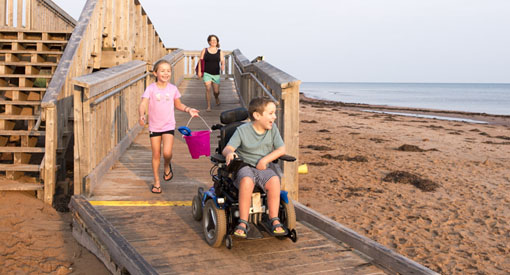
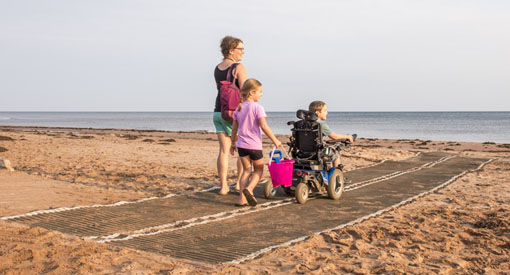
More than a meeting “code”
“The accessibility offer allowed my father to visit the beach for the first time in years.”
“I became a quadriplegic when my daughter was just 2 months old. I had never been to the beach with her until this summer. She is 17 years old now.”
Simple upgrades to the beach complex and the addition of accessibility mats and wheelchairs on the beach have upgraded the service offer, making it user-friendly for everyone. These changes had a profound impact on the lives of those individuals who never expected to enjoy a beach vacation with their loved ones, or to swim in the ocean with their children.
Inclusive by Design
Parks Canada aspired to not only be accessible to visitors, but to also be inclusive. In response, Gros Morne National Park wanted to provide an autism-specific, safe, enjoyable experience for everyone, while limiting stress and challenges for visitors.
By making a few small but significant changes, Gros Morne National Park turned rustic cabins into autism-friendly accommodations, in addition to offering other resources and events. This resulted in bringing awareness to Autism Spectrum Disorder (ASD) and making their accommodations more inclusive for people with sensory needs.
The team outfitted rustic cabins by including safety features such as extra locks, window coverings and securing potentially mobile objects. They worked in collaboration with the Autism Society Newfoundland and Labrador (ASNL) to properly outfit the cabin with a mobile sensory kit. They also worked together to develop a preregistration form and a special trip planning information package for visitors with special needs, available on the Parks Canada website. In addition, the park provided ASD awareness training to campground staff.
This initiative received significant media coverage, being shared on CBC Radio, Radio-Canada, CBC Website, Newstalk 1010, as well as countless other news sources. The article published by CBC web alone was shared over 10,000 times!
In 2018, the park offered an autism-specific Learn to Camp program in partnership with ASNL.
The inclusive rustic cabins were booked several times by families interested in the new space and sensory kits.
Information was added to the Parks Canada website highlighting all inclusive and accessible offerings to visitors with special needs.
Escape Room Experience
The profile of visitors to Parks Canada places is changing, as are the demographics of Canada. People are attracted to national historic sites for different reasons and the ways in which visitors connect with places, stories and people are evolving. Developing new and innovative programs and services allows more Canadians, including youth and newcomers, to learn and care about Canada’s environment and history, and is crucial for Parks Canada to attract wider, more diverse audiences and remain relevant to Canadians.
- 378 participants booked this enhanced program in 2018
- The experience generated over $9,000 in 7 weeks
- Staff morale and engagement was improved by offering this program
- The knowledge gained from this experience helped visitors to better understand the story of the site, kept them engaged and created positive visitor experiences
- A promotional video was created to highlight the new visitor experience opportunity
Parks Canada staff explored several opportunities to pair and draw inspiration from pop culture and the Norse history of L’Anse aux Meadows National Historic Site to immerse visitors in a one of a kind gaming adventure called “The Test of Tykir: Escape Room.” This escape room experience was designed for Parks Canada by Escape Quest, a Newfoundland business, and installed in a replica sod hut at L’Anse aux Meadows. It is an immersive experience, set in the legends of the Vinland Sagas. It was installed in an otherwise unused sod hut within the re-enactment grounds of the site in a way that supports visitor understanding of the commemorative integrity of the site.
This initiative was launched for Parks Day – July 21, 2018 – and was successful on many levels. The program was well-attended, generated revenue, created new interest through social media and attracted new audiences to the site.
Equipped Members
Upcycling Obsolete Uniform Items
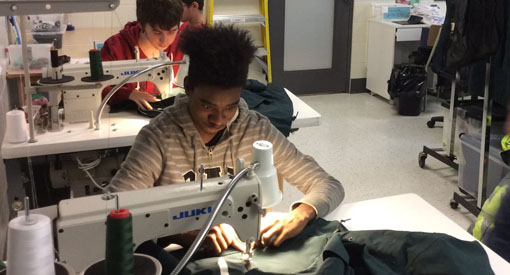
In 2014, Parks Canada completed the transition to the new core uniform. As a result, the upcycling or divestiture of obsolete uniform items was required, in accordance with relevant Government of Canada acts and policies. Working with the Social Science team, an internal survey of Parks Canada team members was done in late 2016. According to the survey results, Parks Canada had approximately 4,106 lbs of branded and 3,324 lbs of unbranded obsolete uniform items.
The Brand Team developed a strategy to recycle/divest of the obsolete uniform items. The goal was to find the most fiscally, environmentally, and socially responsible methods.
The Brand Team developed a set of instructions on how to properly recycle obsolete and current worn-out uniform items, and posted them on ParksNet.
All Parks Canada locations are encouraged to repurpose obsolete uniform items wherever possible. Best Practices for repurposing obsolete uniform items from our colleagues across the country include: repurposing the polo shirts and t-shirts for rags, repurposing the fleece jackets and vests for mittens and using Gore-Tex items to create extra tent straps, etc.
Parks Canada is working with Réseau CFER, a non-profit organization in Québec to securely remove identifiers and re-use the Gore-Tex Jackets and Northern Parkas. Réseau CFER operates a school program recognized by the Ministry of Education for youth-at-risk.
Obsolete branded items and current uniform items that are worn out/unusable are shredded by Debrand Services. Debrand was chosen because they use a fiber reclamation process whereby all shredded material is repurposed and used in automotive seat stuffing, furniture padding, boxing glove and punching bag stuffing, etc. Shredding and repurposing of these textiles has been deemed the most cost-effective and environmentally and socially responsible method for Parks Canada to recycle/divest of its obsolete branded uniform items.
The Brand team also worked with the Law Enforcement Branch and Nunavut Field Unit to recycle obsolete park warden items (pants, fleece jackets and vests). Gently used Parks Warden pants were donated to the not-for-profit Gjoa Haven Hunters and Trappers Association for use by members involved in the Guardian Program who help the Nunavut Field Unit and Parks Canada monitor and protect the Wrecks of HMS Erebus and HMS Terror National Historic Site. Obsolete fleece jackets and vests were donated to the not-for-profit Gjoa Haven's Community Sewing Group to re-purpose into practical items like mittens and mitten liners.
Province House Virtual Reality Experience
During the summer of 2018, thousands of visitors experienced Province House: Virtual Reality, an interactive and fully immersive exhibit that offered an experience of Province House like never before.
Youth engagement was key in developing this innovative way to provide visitors with unique access to Province House, through an ongoing partnership between Parks Canada and the University of Prince Edward Island.
Province House: Virtual Reality was designed and produced in collaboration with students from the University of Prince Edward Island’s Faculty of Sustainable Design Engineering. This unique program has a project-based curriculum that focuses on the engineering design process. Over 1,300 hours were spent by the design team in planning, testing, and developing this immersive experience. Additional hours were spent by students from the Animation Studies program at the University of Trinidad and Tobago, who digitally re-created the building’s interior.
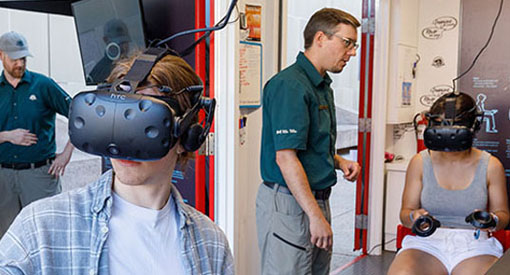
The experience was highly beneficial to the students, and provided them with an opportunity to build their skill set by creating a product that conveyed the important conservation work being undertaken by the Government of Canada at Province House National Historic Site.
A video was created to share a bit more information about the project and the students who worked with Parks Canada to develop this amazing visitor experience offer.
Looking ahead to 2020
The anecdotes above demonstrate Parks Canada's commitment to creating an innovative public service that is enjoyable to work in. We are currently developing an innovation training course for all Agency members as well as concrete opportunities to work on innovative projects. Our agile, inclusive and well-equipped organization allows us to continue to protect and showcase our natural and cultural heritage for current and future generations.
- Date modified :